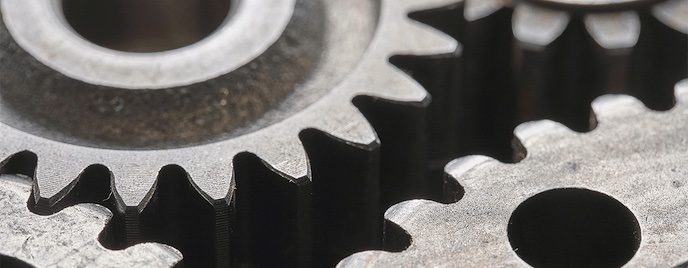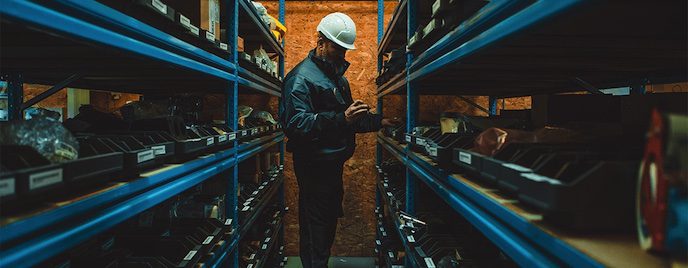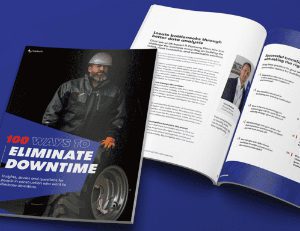

The industry is known for its enormous time and cost overruns, pollution, and troublesome carbon emissions, and only around 5% average earnings before interest and taxes.
At Trackunit, we want to change that, and our purpose is clear: Let’s eliminate downtime across the construction value chain.
Eliminating downtime across the value chain is a mammoth task and in this article we outline examples and our perspectives on collaboration and digitization. Several other companies from a variety of industries have successfully collaborated across their value chains to increase efficiency and raise their profit margins. But how can we do the same in construction? How can we move beyond the building processes and machine maintenance, to truly make an impact on the industry?
In other industries, such as automotive or tech, collaboration and control of the value chain across multiple tiers, has been enabled by digital technologies for more than two decades.

Take Jaguar Land Rover. Today, they place orders for custom parts just hours before they are needed on the manufacturing line. These parts show up just-in-time and in sequence to match the assembly slot schedule announced 8 hours earlier.
In another industry, Dell can run a global supply chain, holding only six days of inventory, yet they can deliver custom-configured computers to end consumers within days. By-passing traditional retailers.
Both operate in complex global supply chains, sourcing thousands of components from hundreds of suppliers.
But, through digital collaboration, they can coordinate the delivery of modern computers and cars to end-users in a matter of days.
By doing so, they deliver significant value upstream and downstream in their value chains while increasing profits.
At Trackunit, we see an opportunity to help move the construction industry forward. To learn from other industries and reap the same benefits by making decision making collaborative and data-driven.
In an attempt to optimize site productivity and minimize inefficiencies, hundreds or thousands of decisions are made on construction sites daily. The industry is moving towards a future where contractors will work in close collaboration with machine suppliers through digital market places and direct-online channels.
This collaboration can only take place if all entities supplying the construction site have full visibility, agility, and capability to respond to demands through digital means.
Suppliers of equipment and machines must have access to data about the location, status, and availability of equipment. This data must be integrated into operational systems and processes, giving suppliers the ability to respond to shifting demands in near real-time. Our industry has the chance to match demand and supply collaboration like Dell and Jaguar Land Rover. Coordinating demand and supply of goods and construction equipment using technology that enables collaboration can drive down cost and improve speed and agility while minimizing waste and downtime.

Repair and service of construction equipment is often missed or forgotten, leading to machine breakdowns when they are needed the most, a result of a lack of access to real-time data. Servicing or repairing machines typically relies on manual inspections and follows an emergency response process rather than a preventive maintenance cycle.
Rolls Royce have been able to transform industries by embracing data as a strategic asset. The British manufacturer takes data generated by IoT sensors, aggregates it, and analyses it in the cloud providing new insight into the live performance of its products – from jet engines and helicopter blades to power generation systems and marine turbines. Data capability is helping Rolls Royce predict equipment issues and maintenance requirements, enabling them to serve the value chain and add incremental value.
Similar technology can increase efficiency and reduce maintenance costs, waste, and downtime of machines for machine owners in the construction industry.
Machines equipped with IoT devices can send usage data and health status updates to a central control tower, enabling proactive responses when machines need attention. Through technology, service and repair costs go down, first-time fix rates go up, and end-customer satisfaction is improved. All entities in the value chain stand to reap the benefits of collecting and analyzing data, just like other industries have been able to do. Imagine using data about low machine utilization to deliver more value to customers. Or using idling times to support the optimal delivery process for other segments of the value chain. The opportunities are there, and we need to seize them.

Across industries, leading enterprises are heavily investing in technology. They are using digitalization and data to develop competitive products and services.
The days where contractors rent machines, only to use them for seven days out of the 3-month rent agreement are fading. Expectations in the industry are changing, and early adopters of technology will be able to compete. Contractors will demand the ability to rent and access machines without human interaction – on site. They will demand to be billed for the actual machine hours and will require proactive rental suppliers that make sure they are equipped with the right machine for the job. Rental companies will soon have to be able to utilize data to provide new services to end customers while adapting to new business and pricing models. OEMs have to look no further for inspiration than GE. An OEM that has managed to leverage technology to build a modern after-sales business. Using remote monitoring and diagnostics, GE can deliver condition-based maintenance on their customers’ equipment. Increasing revenue and lowering costs. GE are also able to use the data to generate valuable insights that fuel product innovation and market differentiation.
There needs to be a common drive towards gathering data from high-value equipment and machines, and turning that data into actionable insights.
Eliminating downtime stretches across small scale changes that players can make individually to larger-scale disruption in the industry, that will impact the entire value chain. Data will help industry players deal with new demands, changing market dynamics, and stricter regulation on safety and sustainability. To find out more about eliminating downtime and the impacts that it can have on the entire value chain, subscribe to our monthly newsletter. You’ll get 3 hand-picked articles about digitization, data-sharing, leadership, and more.

Never miss an insight. We’ll email you when new articles are published on this topic.


